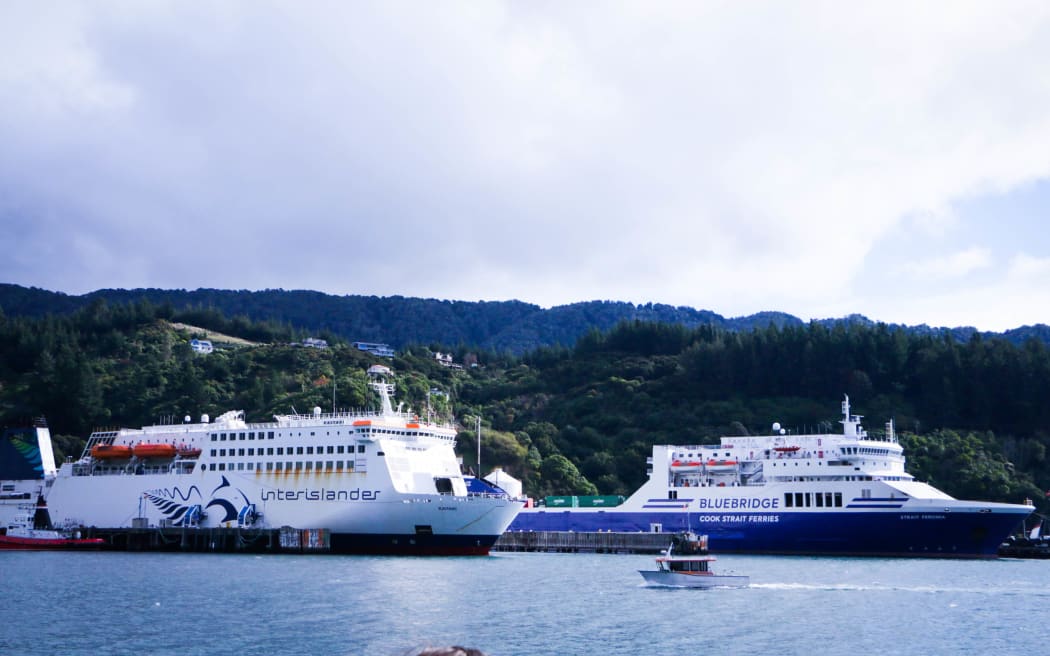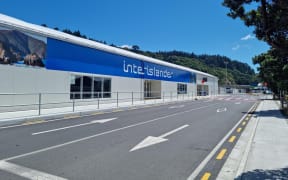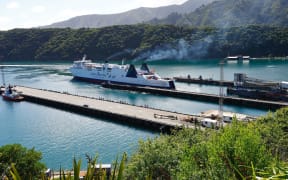
Bluebridge and Interislander ferries in Picton, Marlborough Sounds. Photo: RNZ/ Rachel Thomas
KiwiRail says it is now looking at buying second-hand ships for the Cook Strait ferry service, and is asking what to do about the terminals.
It has blamed poor project governance in part for cost escalations in its Interislander replacement Project Irex, sunk when the government balked in December at rising terminal rebuild costs.
The Crown-owned company is in the processing of cancelling an order for two new ferries worth almost $600m - its suggestion it might get them built then sell them on, was earlier quickly quashed - with KiwiRail saying today it does not know what cancelling those, and quitting 150 contracts for the terminal works in Wellington and Picton, will cost.
Chief executive Peter Reidy told MPs at a select committee at Parliament there are only 22 second-hand ships worldwide that fit the bill - such as being rugged enough for the Strait - and none are for sale.
Any ferry must be at most 10 years old to ensure it has modern safety back-up systems.
It also was not as if the question of how to upgrade the ageing terminals had been answered, Reidy said.
"The one question I will sort of leave you with is whilst we're moving on from the ships, the terminals have to be built."
Not just their terminal, but Centreport and the Bluebridge terminal needed upgrades in the next decade, which should now be coordinated, he added.
But this was now a question for the Transport Ministry and all New Zealand, not KiwiRail.
"The problem to be solved is who pays for the terminal?" Reidy said.
"Does it involve private capital?"
Cruise ships and their berthing could be brought into it, said KiwiRail chair David McLean.
McLean told MPs it was with "horror" in late 2022 that revised Irex costings showed a huge blowout.
He and Reidy were new to KiwiRail around this time, coming in after the early costing in 2018 of $800m had begun rising.
They had those sums redone by experts and they "came up with a completely different set of numbers, to our horror, which really showed us it was going to be well over $2 billion", McLean said.
"It was a surprise to everyone. We didn't really have that analysis.
"And why didn't we? Because it hadn't been governed properly internally."
McLean agreed with MP Tom Rutherford the early price in 2018 for the ferry project was "pie in the sky".
Reidy overhauled the governance as top priority, McLean said.
Urgent talks with ministers ensued, as well as rushed cost-cutting that shaved $200-300m, such as by removing some of the "glitz" from the terminals.
But it was not enough to save the project from the new government's axe.
The two Korean-made ferries were being tailor-made for the run, such as to make wakes that would be kind to Tory Channel, and had been a very good price in 2019 when ordered for about $550m, Reidy said.
Getting similar spec ships now would cost 30-40 percent more, ship brokers had advised.
As for keeping the existing old ferries going past 2026, Norwegian experts would visit in the next two weeks as part of safety assessments of the ships.
"The current indications are, particularly Kaitaki, their view is it's actually in good condition for the age," Reidy said after the committee meeting.
An old valve blew out and Kaitaki's cooling system failed a year ago, and the ship drifted towards rocks for an hour, prompting an overhaul of ferry audit systems.
Finance Minister Nicola Willis said on Thursday that getting ferries that did not have roll-on roll-off tracks for rail freight, was absolutely a possibility.
However, McLean told MPs that KiwiRail's business model was built on a single rail system that allowed freight to move easily across the Strait, subsidising passenger movements.
If ships could not take trains, it would add time to freight movements as containers were double handled, putting customers off, he said.
Irex has swallowed $424m - on ships, port design and some minor wharfside works. It was not sunk and lost money, because they had the designs for Kaiwharawhara now, Reidy argued - though of course any new terminal might not built there; that is out of KiwiRail's hands now.
However, it was not the size of the much larger Korean ferries that had driven the blowout, despite the "rhetoric" around suggesting as much, Reidy said.
Three other factors added $1 billion: $250m of seismic costs were added in due to findings from the Kaikōura quake of 2016 and from needing to lift the new Kaiwharawhara site a whole metre; escalating construction costs; and price rises pegged to the year-long search for a new site.
The terminal needs of the two larger ferries had pushed up terminal costs only 7 percent, he said.
Kaiwharawhara is in a worse quake rupture zone than a site closer to the central city, such as where KiwiRail wanted it initially.






